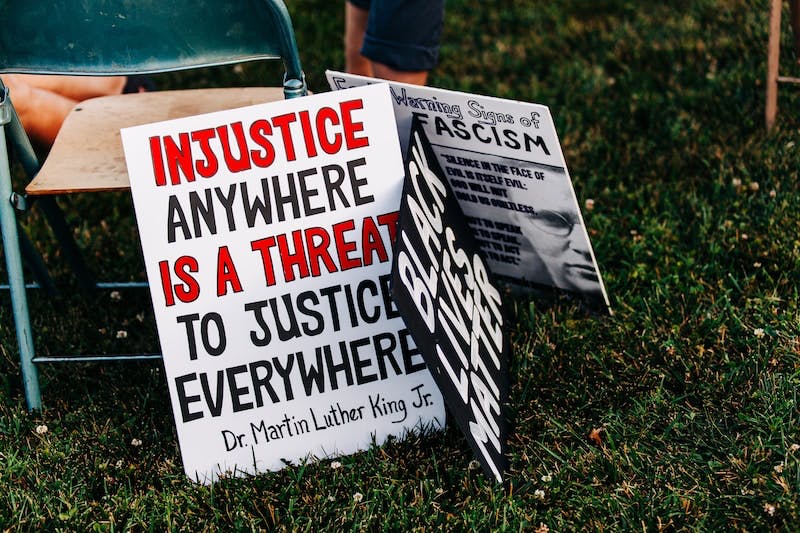This Monday, Americans celebrate Juneteenth to commemorate the day in 1865 when the news of emancipation reached the last group of enslaved African Americans. Juneteenth has been called the longest-running African American holiday, but many non-Black people learned of Juneteenth only recently when it became a federal holiday in 2021. In this newsletter I’d like to offer suggestions especially for non-Black readers to mark Juneteenth this year with a meaningful step toward addressing racism.
|
photo by Heather Mount |
I encourage you to start by considering where you are in a journey toward addressing racism. To do that, let’s look at a well-researched framework that has been used study all sorts of behavioral changes from quitting smoking to school bullying.
The model is simple—it says there are five stages to changing behavior:
- Pre-contemplation
- Contemplation
- Preparation
- Action
- Maintenance
Below you’ll find brief descriptions of each of the stages, along with suggestions of next steps appropriate to that stage.
Here’s what I love about the model—it reminds us that habit formation is not just about the visible action steps. There’s a whole process surrounding behavioral changes, and unless you build that framework, action steps aren’t likely to stick. We all love stories of people who one day decide to quit smoking, trash their last pack, and walk away forever. But no one really does that. A lot happens beneath the surface beforehand, and more afterward to stay committed. Becoming a person who consistently contributes to racial justice works the same way.
See where you fit and choose one step to focus on this Juneteenth.
Stage 1: Pre-contemplation. Folks in this stage are not convinced there’s a problem. They dismiss evidence, defend their actions, and deny anything’s wrong. If you’ve signed up for this newsletter you’re probably not in this stage, but you probably know people who are. The next step for folks in this place is to build awareness that racism is real. In my research, often that happens to a person without them expecting it. Research shows changes at this stage often require a change in circumstances—figuratively or literally ending up on the other side of the tracks. But good teaching about the harmful effects of racism also helps. Next steps for stage one could include watching movies that combine information and story, like Selma or Seven Years a Slave. If you know someone in this phase, it might seem like all you hear is push-back, but your empathy, active listening, and patient nurture do make a difference.
Stage 2: Contemplation. People in this stage know there’s a problem, but they’re indecisive, unsure it’s worth it to address that problem. If you’re in this phase, focus on resources that offer greater depth about racism. Dig into detail with movies like 13th or The Banker, TED talks and shows about how and why to address racism, and books like Why Are All the Black Kids Sitting Together in the Cafeteria, or The New Jim Crow. You can also check evidence of your own racial bias with the Harvard implicit bias test.
Stage 3: Preparation. People in this stage have accepted that the problem is real and worth addressing. They’re in a crucial place of planning, and it’s time to figure out next steps carefully to avoid burning out quickly. If you’re in this stage, find a more how-to focused resource, like How to Fight Racism or How to Be an Antiracist. Investigate local organizations and try some events or volunteer opportunities to see what works for your life. Ask others about their own ways of addressing racism, and agree to take next steps together.
Stage 5: Action. Often we assume this is the only step that matters, but nobody can or should start here. All your preparation prepares you to make changes and participate in your community in new ways in this stage. Next steps if you’re here: Look for new ways you and your organizations can financially support and affiliate with people of color who are leading efforts for racial justice. Find out more about your company, faith community, or other institutions by asking about their diversity and equity practices—do they have policies for people to report race-related incidents? Do they have a plan for hiring from a diverse candidate pool? What practices ensure that implicit bias doesn’t distort hiring, promotions, or client interactions? What language and images appear in communications, and what does that signal about diversity, equity, justice, and inclusion? Find a way to multiply the change by inviting others to take steps along with you.
Stage 6: Maintenance. This step is more important than most people realize. Addressing injustice isn’t just a task to complete, it’s a way of life. In this phase, ask yourself how you’re making this a sustainable part of who you are. At an organizational level, do you have systems in place that continually monitor and address racial inequities? At a personal level, does your everyday life weave in opportunities to learn from leaders of color (podcasts, books, newsletters)? What next step could you take to build mutual relationships that knit you into a diverse community? Have you found people you can go to when you’re discouraged or needing advice? Have you asked someone to be honest with you when you’re not living out your intentions? Are you mentoring others and also being mentored? Maybe it’s time to audit your time use—are you living according to your values, giving yourself grace, and making space for celebration and rest? And connect with others who give you energy. As one woman in my research put it, “You have to dwell where there’s life, or you won’t last.”
You probably have many more ideas. I’d love to hear what you try!
|
|

